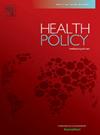Growth and changing landscape of the cost-utility literature: an Australian perspective, 1992-2022
IF 3.4
3区 医学
Q1 HEALTH CARE SCIENCES & SERVICES
引用次数: 0
Abstract
Background
Since the introduction of cost-utility analysis (CUA) in the 1990s, its methodologies and applications have evolved significantly in Australia.
Objectives
To provide a comprehensive overview of the volume, trends, and characteristics of the application of CUA in healthcare decision-making.
Methods
Bibliometric analysis of published CUAs identified from the Cost-Effectiveness Analysis Registry, a `1comprehensive source of CUA data between 1992 and 2022. Multinomial logistic regression models were conducted to explore the associations between ICERs and variables including sponsorship, perspective, and discount rate.
Results
N = 484 unique Australian-based CUAs were analysed. Over the last three decades, the volume and quality of CUAs in Australia have steadily increased. Commonly evaluated interventions included pharmaceuticals (21.5 %), health education/behaviour (18.0 %), and models of care (16.6 %), while diseases of circulatory system, cancers, and metabolic diseases were the most studied health conditions. Only nine CUAs involved First Nations people. Most CUAs (72.9 %) were conducted from a healthcare payer perspective, with only 19.0 % adopting a societal perspective. Approximately half of studies applied a 5 % discount rate, and 50.4 % used a $50,000 WTP threshold. 14.7 % CUAs were sponsored by industry. Regression analyses showed that industry sponsorship, societal perspective, and lower discount rate were positively associated with lower ICERs.
Conclusions
The increasing volume of CUAs underscores the importance of efficient allocation of scare resources in Australian health system. However, gaps remain, particularly in the inclusion of First Nations populations and the societal costs. Further research is needed to address these gaps and to evaluate the impact of sponsorship and discounting on CUA outcomes.
成本效用文献的增长和变化景观:澳大利亚视角,1992-2022
自20世纪90年代引入成本效用分析(CUA)以来,其方法和应用在澳大利亚发生了重大变化。目的全面概述CUA在医疗保健决策中应用的数量、趋势和特点。方法:文献计量学分析从成本效益分析登记处(1992年至2022年的综合CUA数据来源)中确定的已发表的CUA。采用多项逻辑回归模型探讨ICERs与赞助、视角和贴现率等变量之间的关系。结果共分析了484例澳大利亚特有的gaas。在过去的三十年中,澳大利亚的gaas数量和质量稳步增长。通常评估的干预措施包括药物(21.5%)、健康教育/行为(18.0%)和护理模式(16.6%),而循环系统疾病、癌症和代谢疾病是研究最多的健康状况。只有9起案件涉及原住民。大多数caas(72.9%)是从医疗保健支付者的角度进行的,只有19.0%是从社会角度进行的。大约一半的研究采用了5%的贴现率,50.4%的研究使用了50,000美元的WTP阈值。14.7%的gaas由行业赞助。回归分析显示,行业赞助、社会视角和较低的贴现率与较低的icer呈正相关。结论CUAs数量的增加强调了有效配置澳大利亚卫生系统稀缺资源的重要性。然而,差距仍然存在,特别是在纳入第一民族人口和社会成本方面。需要进一步的研究来解决这些差距,并评估赞助和折扣对CUA结果的影响。
本文章由计算机程序翻译,如有差异,请以英文原文为准。
求助全文
约1分钟内获得全文
求助全文
来源期刊

Health Policy
医学-卫生保健
CiteScore
6.40
自引率
6.10%
发文量
157
审稿时长
3-8 weeks
期刊介绍:
Health Policy is intended to be a vehicle for the exploration and discussion of health policy and health system issues and is aimed in particular at enhancing communication between health policy and system researchers, legislators, decision-makers and professionals concerned with developing, implementing, and analysing health policy, health systems and health care reforms, primarily in high-income countries outside the U.S.A.
 求助内容:
求助内容: 应助结果提醒方式:
应助结果提醒方式:


